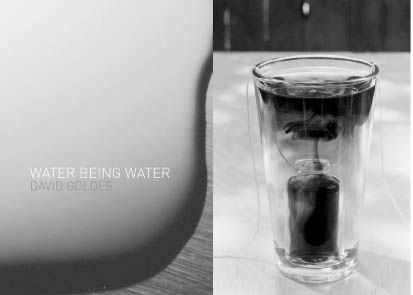Water Being Water: David Goldes
Mason Riddle writes on photographer/scientist David Goldes, whose Water Being Water is available at the Minnesota Center for Photography.

Water Being Water is a sleek thin tome published in conjunction with Art/Science, a 2005 exhibition of photographs by Minneapolis artist David Goldes. In a smart design by Jan Jancourt, the elegant, understated book embodies, in look and feel, photography’s own personal lexicon, the gray scale.
With an abstracted detail of Goldes’ image Puddle as the cover, it generously features twenty of his photographs in uncluttered fashion, one to a page, and includes essays penned by Minneapolis-based writer and photographer Vince Leo, and London-based science writer and editor Philip Ball (whose books include Life’s Matrix: A Biography of Water and Critical Mass: How One Thing Leads to Another).
Organized by photographer and writer Ron Geibert for Wright State University Art Galleries in Dayton, Ohio, the exhibition traveled to Purdue University Galleries in West Lafayette, Indiana. It is a loss that Art/Science did not find a Minnesota venue where Goldes’ understated but provocative photographs, which have been seen little in recent years in the Twin Cities, could have been viewed first-hand by friends, colleagues, and students.
Goldes’ hybrid pedigree is known to many but worth repeating. A 1999 Guggenheim Fellow who is on the faculty of the Minneapolis College of Art and Design, Goldes has a Master of Arts degree in Molecular Genetics from Harvard University and a Master of Fine Arts in Photography from SUNY at Buffalo. He is not the first to leave a profession for the arts, but his work over the last two decades has rarely strayed from the scientific practice of investigating a predetermined problem or idea, repetitive experimentation and documentation of the result of that investigation, and finally, wrapping those results in an aesthetic photographic package that looks more like art than science, but would look like nothing without the scientific underpinnings.
However, Goldes’ images are not scientific experiments in the sense of proving a theory, but rather aesthetic–even spiritual–records of an action and an element using the properties of science. His photographs of water – not the lakes and rivers of Minnesota – as still life, water as a premeditated construct that appears on a tabletop, as if a performer, in conjunction with other objects and elements, that causes us to ponder, do this as well as any of his work.
The book itself seems more a meditation on water, an informational cache on the history and context of water, than a discussion of Goldes’ practice. Leo’s essay, “A Tabletop Beyond Control Is A World Beyond Desire,” takes a somewhat theoretical stance. For Leo, the framework of his thesis is the tabletop and Goldes’ mission is to reconcile impulses of control with those of desire on that tabletop. “The tabletop is also the production site of photographic still life, the purest manifestation of photographic desire;” he writes. “Everything we see triangulates with a photographer’s intention and interior state and nothing more.” He finishes the line of thought this way: “David Goldes’ still lifes are exactly that: products of his control and desire manifest photographically; the world not as he knows it, but as he would like it to be.”
Leo continues with a passionate account of water and its many functions, uses, and guises: how its legendary, symbolic status, as well as its unpredictability, are elucidated in Goldes’ photographs. Through Leo’s use of dichotomy – light vs. dark, a common material vs. metaphorical powers – he crafts a case for the depth of Goldes’ water photographs. “In Goldes’ work, desire and control are negotiated, not pure;” he writes. “They are discovered, not premeditated.” These photographs are visual art and not scientific documentation, however; it’s important that Leo reign in his expansive thoughts to address simply what these photographs do, how they look.
Leo does this with insight and style. “This is not what water looks like; this is what water means. Without us knowing it, Goldes has turned the water in his photographs into something else, something capable of translating water’s creative agency into suggestive symbolic language.” Theory and projection aside, Leo does give Goldes’ photographs of water flesh-and-blood status.
Ball’s essay, “The Life of Water,” is surprisingly informative, a delight to read. Although he touches little on Goldes’ actual photographs, he provides us with so many references for water – literary, scientific, philosophical, anthropological, theosophical, mythical and mystical – one comes to the conclusion that this deft and lucid writer knows more about water than Aquarius. Citing Wordsworth, Bachelard, Darwin, Edgar Allen Poe, Narcissus, King Lear, Leonardo, and Baudelaire, for starters, Ball makes clear that in Goldes’ contemplation of water he’s in good company. “Hydrogen, whose name means ‘water-former’…” Who knew? Or, rather who had thought about what the word “hydrogen” means? Like Leo, Ball ices the photographic cake with provocative metaphysical thought. “Goldes’ images remind us that, with water, there can be no permanence, but at best only moments of precarious, breathless equilibrium.”
In the end, Water Being Water is a book for multiple audiences, those who are interested in Goldes’ longstanding, intelligent photographic presence, those who are interested in contemporary photography, and those who want to know the many sides of H2O.
David Goldes’ “Water Being Water” is available from its publisher, Wright State University Art Galleries, for $25 +$2.50 shipping, from A128 Creative Arts Center, 3640 Colonel Glenn Highway, Dayton, OH 45435-0001.